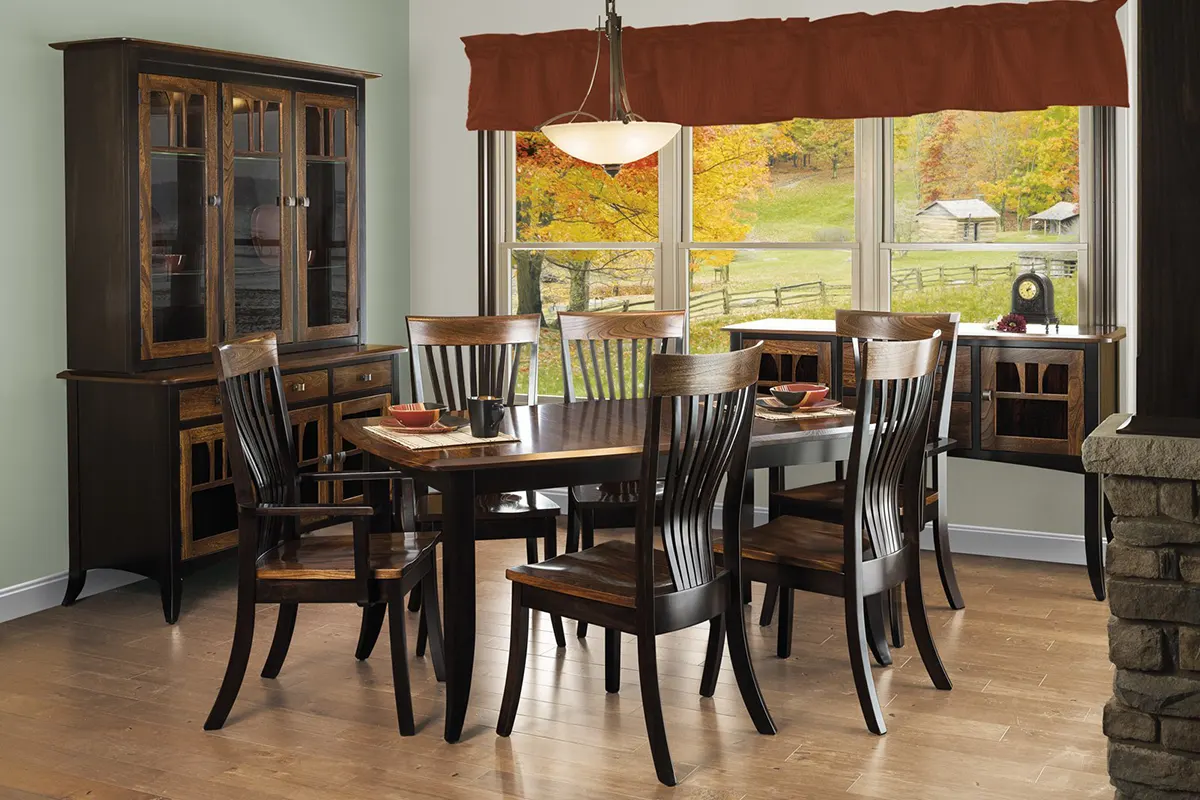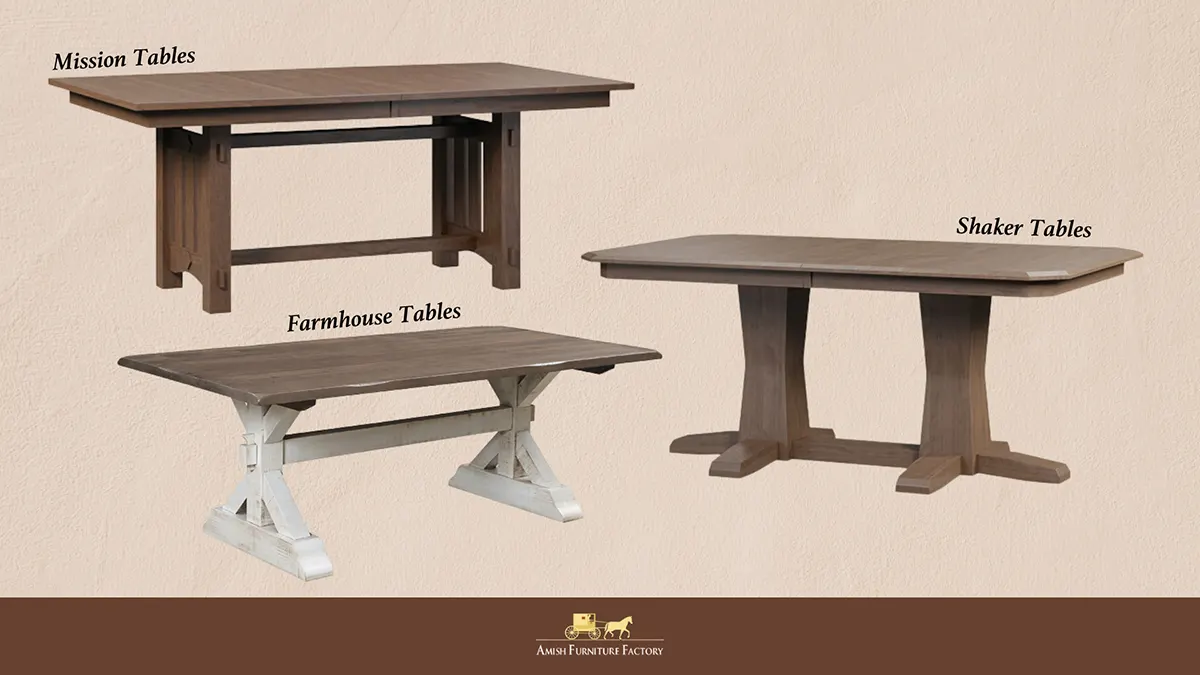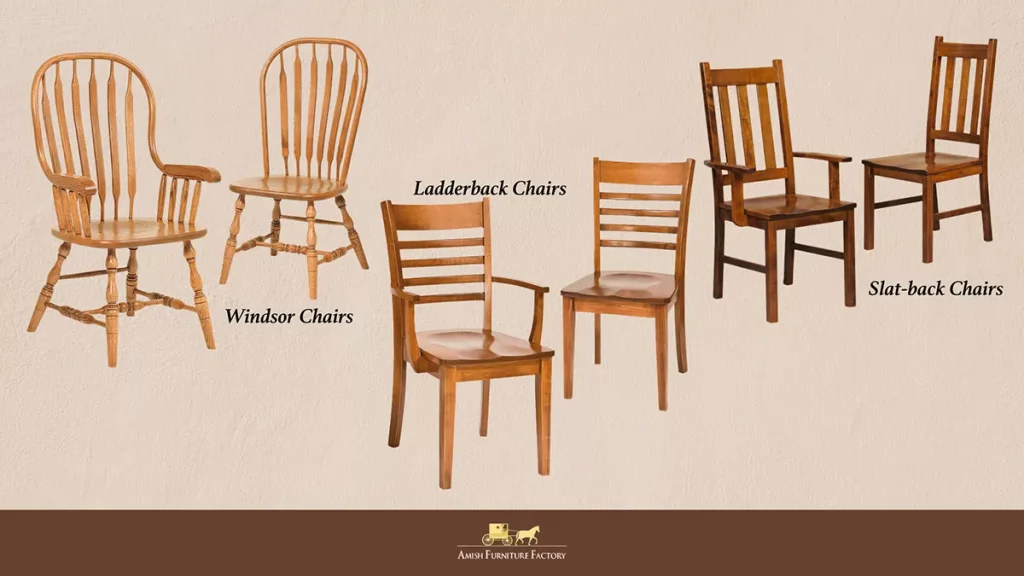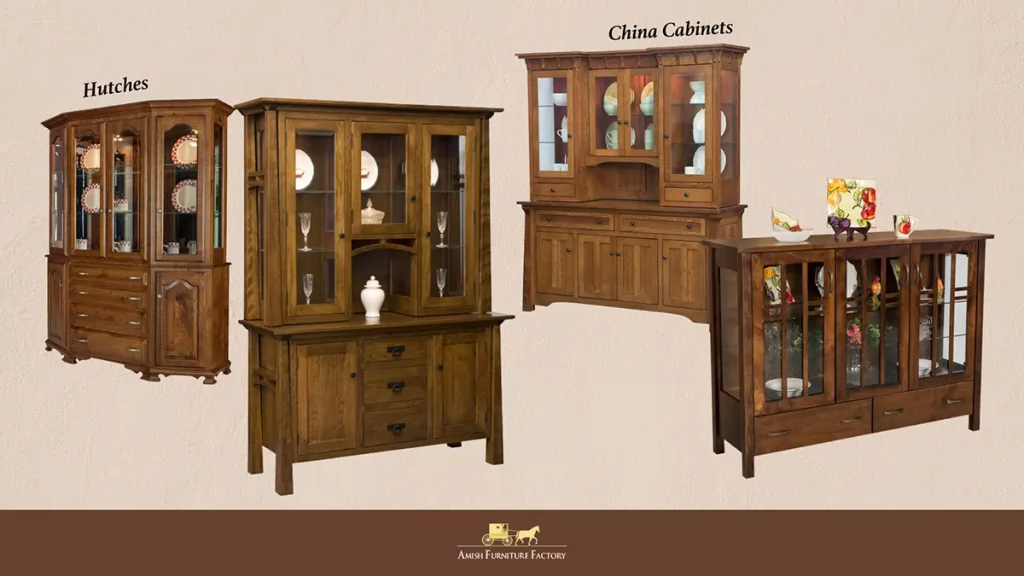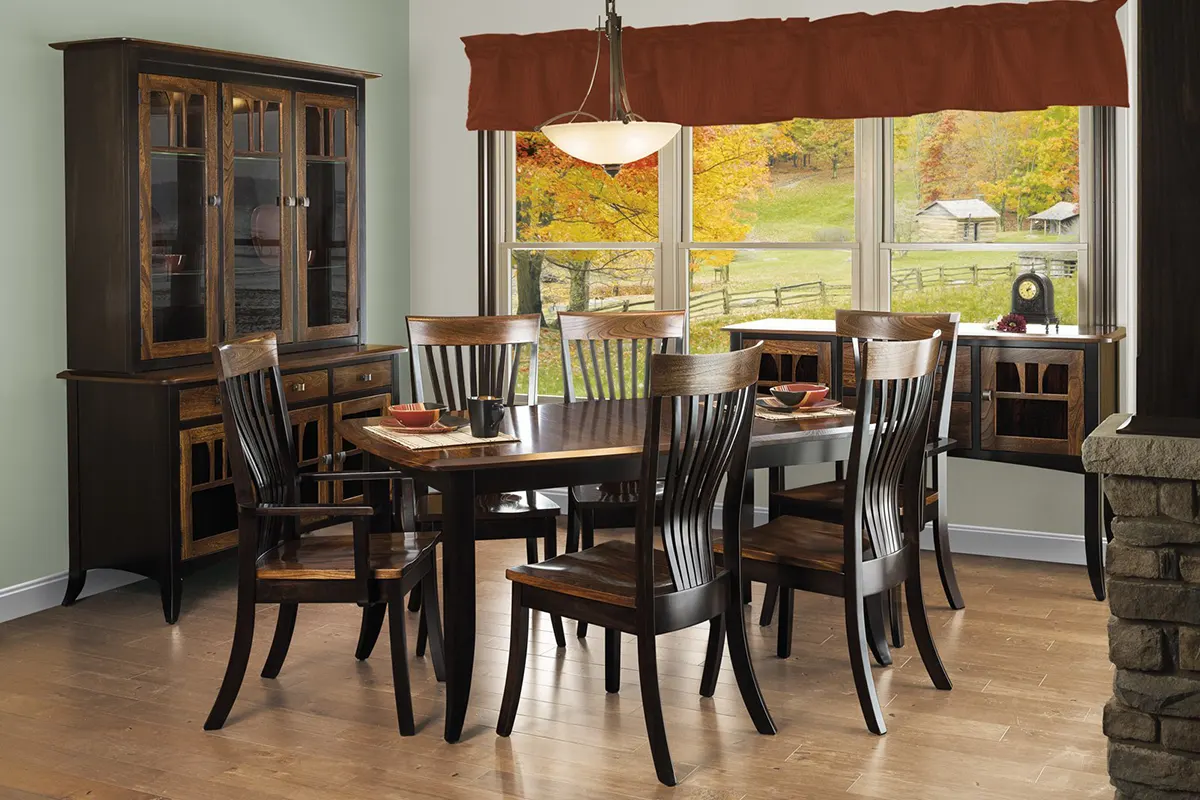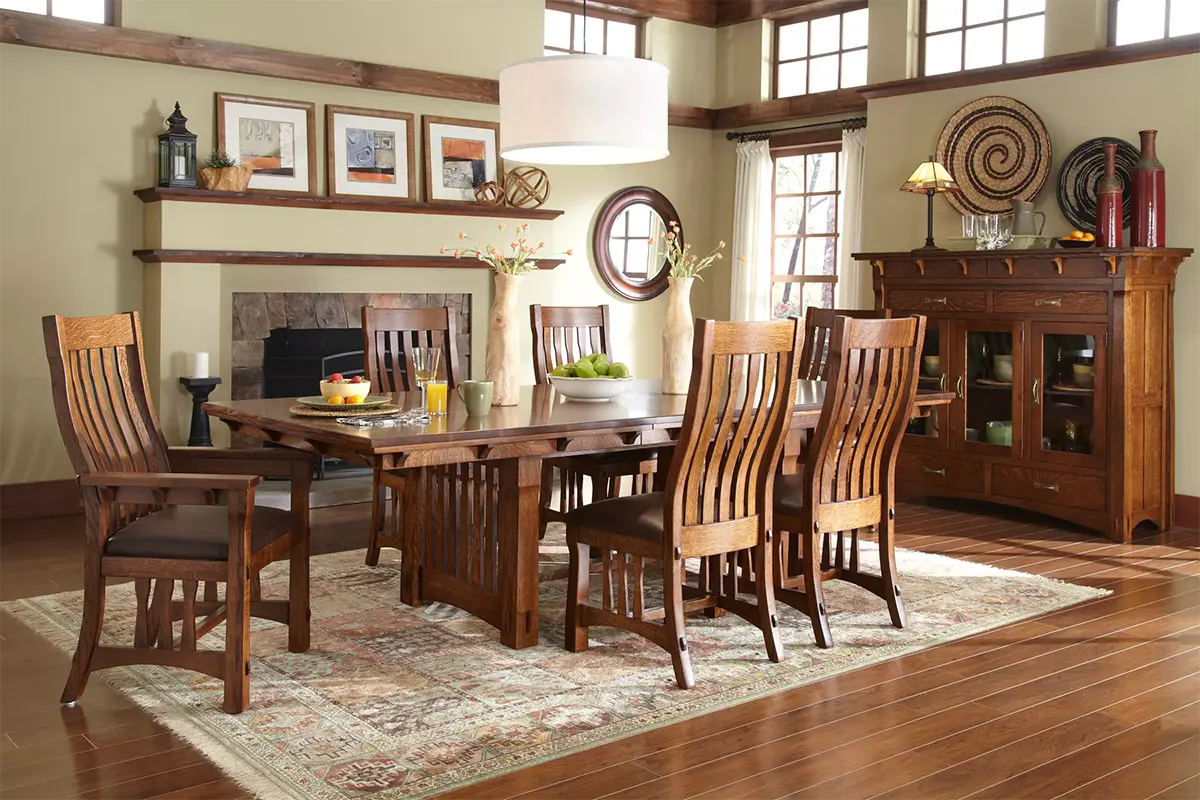
A dining room is more than just a place to eat; it’s the heart of many gatherings and family moments. The furniture that fills this space plays a crucial role in both its functionality and its aesthetic. Amish craftsmanship, renowned for its dedication to quality and timeless design, offers a unique perspective on dining room furniture. However, understanding the various names and styles associated with this type of furniture can be complex.
Key Takeaways
- Amish dining room furniture names carry deep significance, reflecting the design origins, craftsmanship, and history behind each piece.
- Amish hutches, buffets, and cabinets offer ample storage space while enhancing the room’s elegance and providing functionality and style.
- When selecting Amish dining room furniture, consider factors like space, style, and budget to find pieces that meet your needs and elevate your dining room’s overall look.
This article clarifies common dining room furniture names through the lens of Amish craftsmanship. By exploring the distinctive features and terminology of Amish-made pieces, you’ll gain a clearer understanding of how each component contributes to the overall elegance and utility of your dining space.
Overview of Amish Craftsmanship
Amish craftsmanship is a cherished tradition where each piece of furniture reflects dedication and skill. Since the 1920s, when early American folk art gained recognition, collectors have valued Amish furniture for its unique beauty and quality.
Made from solid woods like cherry, oak and maple, these pieces are built to last and age gracefully. Unlike mass-produced items, Amish artisans use traditional, hands-on techniques, with precise furniture joints and hand-sanded surfaces, ensuring each piece is both unique and durable.
Traditional Dining Room Furniture Names and Their Significance
The names given to Amish dining room furniture aren’t just labels—they carry a rich heritage and reflect the purpose and craftsmanship behind each piece.
Amish Dining Tables
Amish dining room tables are the heart of the dining room, designed to bring people together for meals, conversation, and celebration. Their names often reflect their design origins and the craftsmanship involved in their creation.
- Mission Tables: Inspired by the Arts and Crafts movement, Mission Tables are known for their straight lines, sturdy construction, and functional design. The name “Mission” refers to the simplicity and strength of these tables, embodying a no-frills approach to design that emphasizes durability and practicality.
- Shaker Tables: The Shaker-style table is characterized by its minimalist design, clean lines, and tapered legs. Named after the Shaker religious community, which valued simplicity and utility, these tables are crafted to be functional and beautiful.
- Farmhouse Tables: Evoking a sense of rustic charm, Farmhouse tables are built with wide planks and robust legs, often featuring a distressed finish that adds character. The name “Farmhouse” reflects the table’s origins in rural homes where durability and practicality were paramount.
Amish Dining Chairs
Amish dining chairs are essential companions to the dining table, and their names often reflect their distinctive styles and craftsmanship.
- Windsor Chairs: Originating from England, these chairs with rounded backs and spindles became popular in colonial America and have since been a staple in Amish furniture collections. The name “Windsor” is derived from the English town where they were first made.
- Ladderback Chairs: With horizontal slats resembling a ladder, Ladderback chairs offer a rustic yet refined look. The name “Ladderback” directly refers to the chair’s backrest design, providing support and a distinct visual appeal.
- Slat-back Chairs: Similar to Ladderback chairs but with vertical slats, Slat-back chairs are a versatile option that complements a variety of dining tables. The vertical slats offer a more formal look, and the name “Slat-back” highlights Amish craftsmanship’s straightforward, functional design characteristic.
You might be interested to learn about dining arm chair vs. side chair comparison.
Amish Buffets and Sideboards
Amish buffets and sideboards are versatile pieces of furniture that add storage and style to the dining room. Their names often hint at their function and design.
- Buffets: Typically featuring cabinets and drawers, buffets provide ample storage for dining essentials like dishes, linens, and serving ware. The name “Buffet” suggests a piece meant to serve food, but in modern usage, it also refers to its ability to store and display items elegantly.
- Sideboards: Similar to buffets but usually narrower, sideboards are designed to provide additional surface space for serving food or displaying decorative items. The name “Sideboard” comes from its function as a side table that offers storage and serving space.
Amish Hutches and China Cabinets
Amish hutches and china cabinets are designed for storage and display and often become focal points in a dining room.
- Hutches: Combining open shelving with closed cabinets, hutches offer a blend of storage and display options. The name “Hutch” is derived from its traditional use as a place to store and display kitchenware, particularly in rural homes.
- China Cabinets: Taller and more formal than hutches, china cabinets are designed to showcase fine china, glassware, and other prized possessions. The name “China Cabinet” reflects its original purpose of storing and displaying porcelain dishes, but today, it serves as a statement piece in the dining room.
Amish Benches and Settees
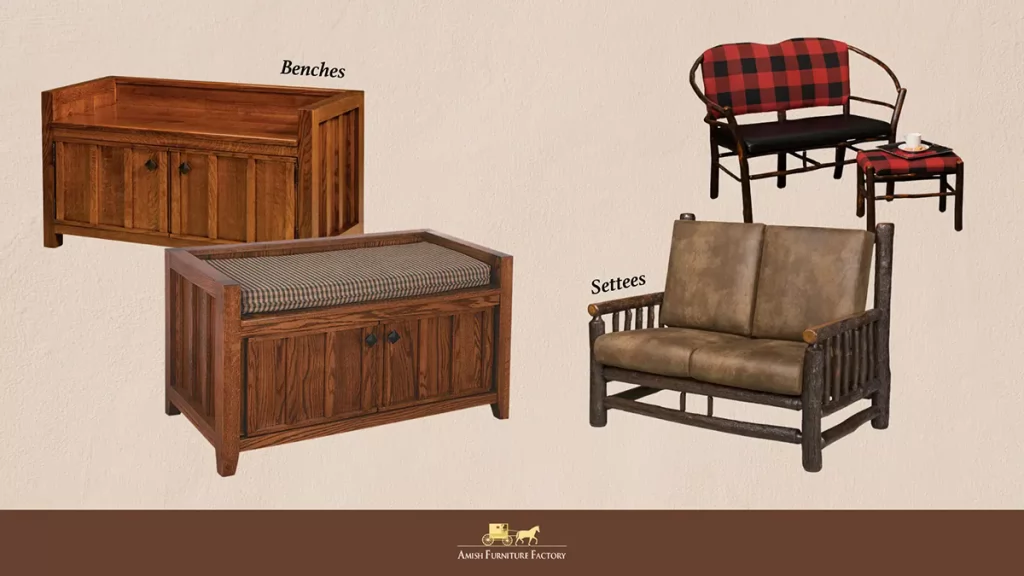
Benches and settees offer flexible seating options that can enhance the style and functionality of a dining room.
- Benches: Simple and sturdy, benches are often used in farmhouse-style settings, providing ample seating without taking up too much space. The name “Bench” reflects its straightforward design and practical use, making it a popular choice for informal dining areas.
- Settees: More refined than benches, settees offer upholstered seating and a touch of elegance to the dining room. The name “Settee” originates from the French word for a small, upholstered sofa, and these pieces are designed to provide comfortable seating with a more formal look.
Storage Solutions in Dining Rooms
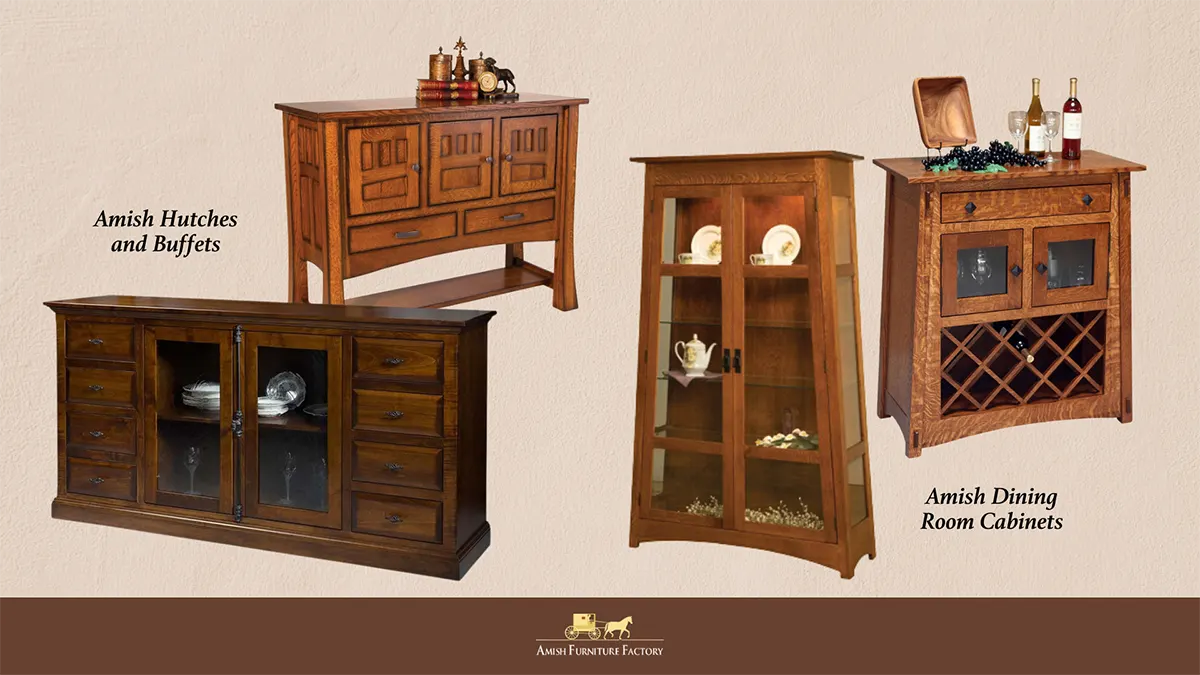
Amish hutches and buffets are universal storage options, combining open shelving and closed cabinets. Ideal for displaying dishes or storing essentials, these pieces add functionality and elegance to your dining room. Sideboards offer additional surface space and storage, perfect for serving food or keeping your dining area clutter-free. Their streamlined design makes them suitable for both modern and traditional spaces.
Amish dining room cabinets provide generous space for those needing extra storage without overwhelming the room. These solid wood pieces are built to last and keep your dining essentials organized and accessible.
Explore our top recommendations for Amish dining room furniture sets and transform your space today.
How to Choose the Right Amish Dining Room Furniture
Choosing the right Amish dining room furniture involves a balance of practicality and style. Start by measuring your space to ensure the furniture fits comfortably. In smaller rooms, opt for compact tables like round or square designs and consider benches to save space.
Select a style that complements your dining room’s decor. Amish furniture comes in various styles, including Shaker, Mission, and Farmhouse, so choose one that matches your aesthetic, whether it’s modern or traditional. Set a budget and focus on essential pieces such as the dining table and storage units.
For table options, rectangular tables work well for larger gatherings, while round or square tables are better for intimate settings. Extendable tables offer flexibility if you need extra seating occasionally.
When choosing Amish made chairs, classic styles like Windsor or Ladderback offer timeless appeal, while slat-back or upholstered chairs add modern comfort. If storage is important, look for buffets or cabinets that fit your needs and enhance your room’s design.
You might be interested in exploring the unexpected fusion of Mediterranean furniture by Amish artisans.
Conclusion
Amish furniture is celebrated for its timeless appeal and robust construction, built to endure and age beautifully. By carefully considering your dining room’s space, style, and budget, you can select pieces that not only fit your needs but also elevate the overall aesthetic of your home.
Whether you choose a classic Windsor Chair, a versatile Buffet, or a refined Hutch, the unique characteristics and craftsmanship of Amish furniture will undoubtedly enrich your dining experience.
FAQ
What makes Amish dining room furniture different from other furniture styles?
Amish dining room furniture is distinguished by its solid wood construction, meticulous craftsmanship, and traditional techniques. Unlike mass-produced furniture, each Amish piece is handcrafted with attention to detail, resulting in high durability and timeless design.
What are the typical finishes used on Amish dining room furniture?
Amish dining room furniture is often finished with natural oils, stains, or lacquer. Natural finishes preserve the wood’s original look and enhance its grain, while stains can add color and warmth.
Are there custom options available for Amish dining room furniture?
Yes, many Amish furniture makers offer custom options. You can often choose from a range of wood types, finishes, and sizes to match your specific needs and preferences.
